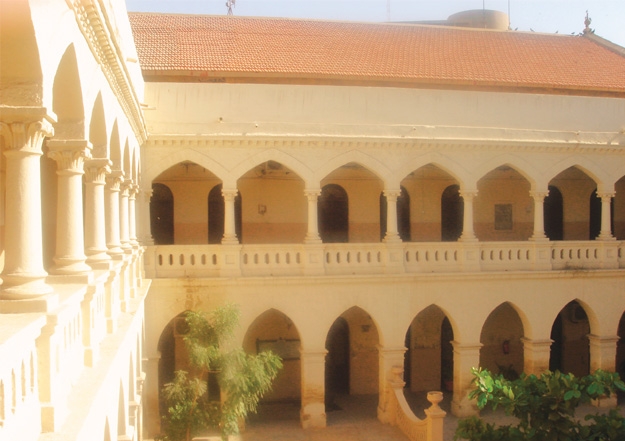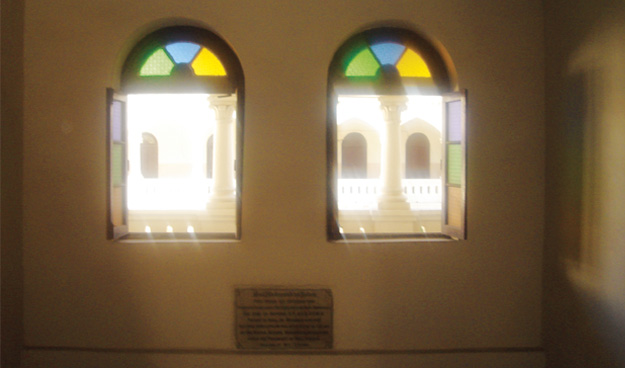
The Sindh Madressatul Islam (SMI) boasts of an impressive list of alumni who have played key roles in the history of Pakistan. Quaid-i-Azam Mohammad Ali Jinnah, Sir Abdullah Haroon, Sir Shahnawaz Bhutto, Sir Ghulam Hussain Hidayatullah, Muhammad Ayub Khuhro, Mir Ghous Bux Bezinjo and Attaullah Mengal have all studied at SMI. But its journey from a secondary boarding school to a university was not an easy one. On the other side of the border, another premier Muslim educational institute, Delhi’s Jamia Millia Islamia, became the Central University of India just 68 years after its founding, the alma mater of the founder of Pakistan had to wait for more than a century before it attained university status.
In 1885, Khan Bahadur Hassanally Effendi was inspired by the efforts of Sir Syed Ahmed Khan in promoting education in the sub-continent and decided to open a similar institute for the Muslims of Sindh. Effendi selected a plot of land in Qafila Seria (where SMI exists today) for the cause and inaugurated the Sindh Madressatul Islam on September 1,1885. Modelled after the Aligarh Oriental College, it soon became the bastion of education in Sindh.
The institute prided itself on imparting subsidised, modern education along with religious instruction. It was here that the Quaid-i-Azam Mohammad Ali Jinnah studied from 1887 to 1892. The Quaid returned once again to the halls of SMI in 1943, when he inaugurated college classes at his beloved alma mater. It was during this period that prominent European academicians including Sir Thomas Henry Vines served the institution as its principals.

1947 brought with it partition, and as the refugees from across the border started pouring into Pakistan, it was SMI that rapidly converted its hostels into temporary residential rooms for them.
It was an ironic day in 1972, when even the Sindh Madressatul Islam could not resist the advent of ‘Islamic Socialism’ and was nationalised under Prime Minister Zulfikar Ali Bhutto. For two years it remained under the administrative control of the Sindh Government but in 1974, it was handed over to the federal education ministry.
Eleven years later, on 1st September 1985, General Ziaul Haq announced the restoration of college status for SMI, which had been taken away after nationalisation. Despite Zia’s promise, college status was actually withheld from SMI until 1994, when Dr Mohammad Ali Shaikh became the Principal. He finally succeeded in elevating SMI to the college level with the help of the then federal education minister, Syed Khurshid Ahmed Shah in 1995, in the second government of Benazir Bhutto.

It was under the leadership of Dr Shaikh that the historic institution began to show signs of its former splendour. Over the years the beautiful stone walls had been covered by plaster, and by utilising sand blasting techniques, the archaeological beauty of the historic gothic-styled buildings was finally restored. New computer laboratories were added, new books were purchased for the library and the auditorium was renovated. Secondary classes for girls were also introduced at this time.
Between 1997 and 1999, the then federal education minister, Mr Ghous Ali Shah took a special interest in SMI and formed a committee chaired by noted academician and intellectual Jameel Ahmed Jalibi to prepare the charter and related material for the proposed SMI University. In 2008, the Pakistan People’s Party came into power and picked up where the PML-N left off.

Finally on May 18, 2010, the President of Pakistan Asif Ali Zardari, the great grandson of Hassanally Effendi, attended the inaugural session of a National Conference on Jinnah, organised by the SMI at the Sindh Governor House and announced university status for SMI along with a grant of 225 million rupees. The bill formally bequeathing university status to SMI was unanimously passed from the Sindh Assembly in the form of an act on December 22, 2011. All the elected members of the political parties lauded SMI for providing quality education in Sindh since the 19th century.
Coming full circle, SMI is once again getting possession of its three oldest buildings ie Hassanally House (built in 1909), Khairpur House (built in 1912) and Sardar House (built in 1919), which are under the control of the SM Science College. Historically, these buildings had remained a part of the SMI up to 1972 but after nationalisation, the college section remained with the Sindh government and only the school section was under the control of federal education ministry.

Interestingly, these three buildings were the same ones which housed both students and refugees for almost half a century. Now preparations are underway to welcome the first batch of students at the SMI University in January 2013. With this, yet another generation will get the chance to live the motto of this legendary institute: “Enter to Learn, Go forth to Serve”
Published in The Express Tribune, Sunday Magazine, December 23rd, 2012.
Like Express Tribune Magazine on Facebook and follow at @ETribuneMag





















1713418975-0/MehwishKhans-(1)1713418975-0-270x192.webp)


1712071304-0/image-(14)1712071304-0-270x192.webp)





















COMMENTS
Comments are moderated and generally will be posted if they are on-topic and not abusive.
For more information, please see our Comments FAQ